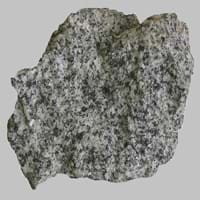Diorite and Coquina
Definition
Definition
Diorite is a grey to dark-grey intermediate intrusive igneous rock composed principally of plagioclase feldspar,biotite, hornblende, and pyroxene
Coquina is a sedimentary rock that is composed either wholly or almost entirely of the transported, abraded, and mechanically-sorted fragments of the shells of molluscs, trilobites, brachiopods, or other invertebrates
History
Origin
Unknown
European Foreland Basins
Discoverer
Unknown
Unknown
Etymology
From early 19th century coined in French, formed irregularly from Greek diorizein distinguish
From Concha (Latin)+ Coquina(Spanish) +conch(English)= Couquina (mid 19th century)
Class
Igneous Rocks
Sedimentary Rocks
Sub-Class
Durable Rock, Hard Rock
Durable Rock, Soft Rock
Family
Group
Plutonic
Not Applicable
Other Categories
Coarse Grained Rock, Medium Grained Rock, Opaque Rock
Coarse Grained Rock, Opaque Rock
Texture
Texture
Phaneritic
Clastic
Color
Black, Brown, Light to Dark Grey, White
Beige, Buff, Orange
Maintenance
Less
More
Durability
Durable
Non-Durable
Water Resistant
No
No
Scratch Resistant
No
No
Stain Resistant
No
No
Wind Resistant
Yes
No
Acid Resistant
No
No
Appearance
Shiny
Layered, Banded, Veined and Shiny
Uses
Architecture
Interior Uses
Decorative Aggregates, Interior Decoration
Decorative Aggregates, Homes, Hotels, Interior Decoration
Exterior Uses
As Building Stone, As Facing Stone, Garden Decoration
Garden Decoration, Office Buildings
Other Architectural Uses
Curbing
Curbing
Industry
Construction Industry
As Dimension Stone, Cement Manufacture, Cobblestones, Construction Aggregate, for Road Aggregate
Building houses or walls, Construction Aggregate
Medical Industry
Not Yet Used
Not Yet Used
Antiquity Uses
Artifacts, Monuments, Sculpture, Small Figurines
Artifacts, Monuments, Sculpture, Small Figurines
Other Uses
Commercial Uses
Creating Artwork, Curling
Creating Artwork
Types
Types
Not Available
Not Available
Features
Typically speckled black and white.
Available in Lots of Colors and Patterns, Is one of the oldest rock
Archaeological Significance
Monuments
Used
Used
Famous Monuments
Data Not Available
Data Not Available
Sculpture
Used
Used
Famous Sculptures
Data Not Available
Data Not Available
Pictographs
Not Used
Used
Petroglyphs
Not Used
Used
Figurines
Used
Used
Fossils
Absent
Present
Formation
Formation
Diorite is a coarse-grained intrusive igneous rock which contains large interlocking and randomly oriented crystals and forms when molten lava does not reach the Earth’s surface and cools down in the Earth’s crust.
Coquina is a sedimentary rock which is formed when billions of small clam-like seashell, called Coquina, or cockleshell are die and hence are deposited, buried and turns into a rock when pressure is applied.
Composition
Mineral Content
Albite, Amphibole, Apatite, Biotite, Feldspar, Hornblade, Ilmenite, Magnetite, Muscovite or Illite, Olivine, Plagioclase, Pyroxene, Quartz, Sulfides, Titanite, Zircon
Apatite, Augite, Bronzite, Calcite, Chert, Chlorite, Clay Minerals, Epidote, Feldspar, Garnet, Micas, Muscovite or Illite
Compound Content
Silicon Dioxide
CaO, Carbon Dioxide, Iron(III) Oxide, MgO
Transformation
Metamorphism
Yes
No
Types of Metamorphism
Cataclastic Metamorphism, Contact Metamorphism, Regional Metamorphism
Not Applicable
Weathering
Yes
Yes
Types of Weathering
Biological Weathering, Chemical Weathering, Mechanical Weathering
Biological Weathering, Chemical Weathering, Mechanical Weathering
Erosion
Yes
Yes
Types of Erosion
Chemical Erosion, Coastal Erosion, Water Erosion
Coastal Erosion, Sea Erosion, Water Erosion, Wind Erosion
Properties
Physical Properties
Hardness
6-7
1-2
Grain Size
Medium to Coarse Grained
Coarse Grained
Fracture
Not Available
Irregular
Streak
Bluish Black
White
Porosity
Very Less Porous
Highly Porous
Luster
Shiny
Dull to Vitreous to Submetallic
Compressive Strength
225.00 N/mm2
7
Not Available
Cleavage
Not Available
Not Available
Toughness
2.1
Not Available
Specific Gravity
2.8-3
1.10-2.24
Transparency
Opaque
Opaque
Density
2.8-3 g/cm3
2.8-2.9 g/cm3
Thermal Properties
Resistance
Heat Resistant, Pressure Resistant, Wear Resistant
Heat Resistant, Impact Resistant, Pressure Resistant, Wear Resistant
Reserves
Deposits in Eastern Continents
Asia
Not Yet Found
Not Yet Found
Africa
Egypt
Not Yet Found
Europe
Finland, Germany, Italy, Romania, Sweden, Turkey, United Kingdom
United Kingdom
Others
Not Yet Found
Not Yet Found
Deposits in Western Continents
North America
USA
USA
South America
Argentina, Bolivia, Chile, Colombia, Ecuador, Peru
Not Yet Found
Deposits in Oceania Continent
Australia
New Zealand, Western Australia
Not Yet Found
All about Diorite and Coquina Properties
Know all about Diorite and Coquina properties here. All properties of rocks are important as they define the type of rock and its application. Diorite belongs to Igneous Rocks while Coquina belongs to Sedimentary Rocks.Texture of Diorite is Phaneritic whereas that of Coquina is Clastic. Diorite appears Shiny and Coquina appears Layered, Banded, Veined and Shiny. The luster of Diorite is shiny while that of Coquina is dull to vitreous to submetallic. Diorite is available in black, brown, light to dark grey, white colors whereas Coquina is available in beige, buff, orange colors. The commercial uses of Diorite and Coquina are creating artwork, curling.
|
||
|
||
|










